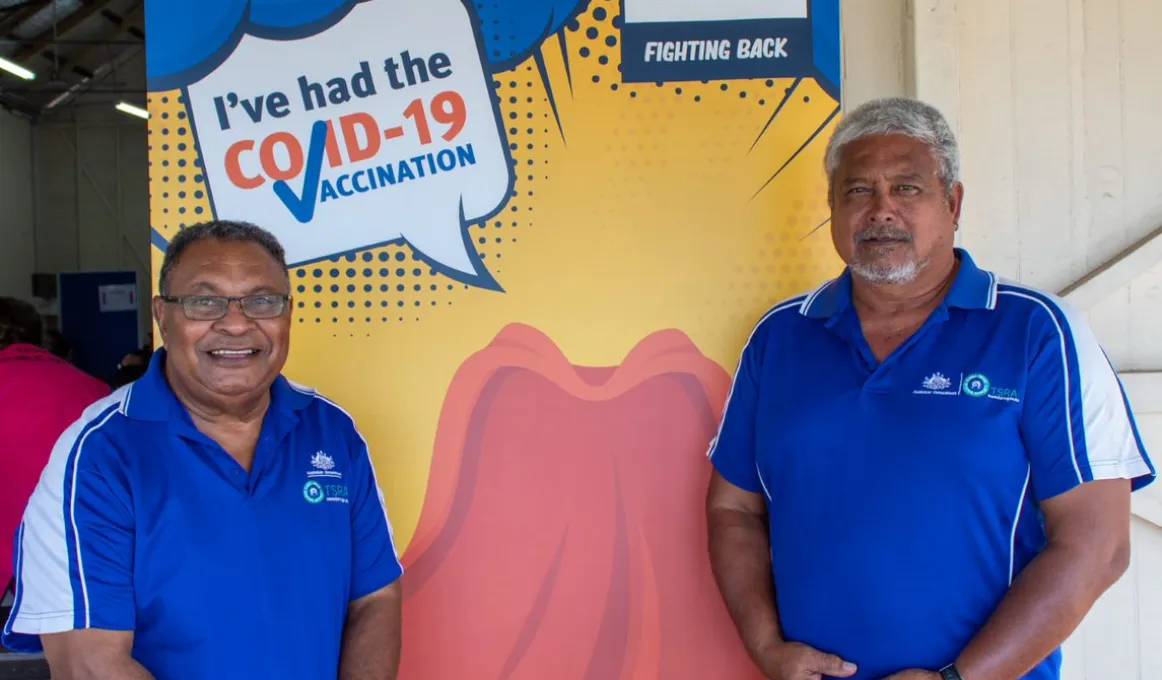Impressive COVID-19 vaccination rates for the Torres Strait and NPA region

The Torres Strait Regional Authority (TSRA) congratulates the communities of the Torres Strait and Northern Peninsula Area (NPA) region for their participation in the COVID-19 vaccination rollout.
Media Release - TSRA
The Torres Strait Regional Authority (TSRA) congratulates the communities of the Torres Strait and Northern Peninsula Area (NPA) region for their participation in the COVID-19 vaccination rollout. The TSRA also acknowledges the consistent efforts by Queensland Health in providing vaccinations to our communities.
To date, nearly 21,500 vaccinations have been administered and of the region’s eligible population aged 12 years and over, 54% of the Torres Strait and 36% of the NPA are now fully vaccinated.
Seisia is the most vaccinated community in the NPA region with 57% of the eligible population aged 12 years and over now fully vaccinated.
Meanwhile, 71% of the Kubin and Iama communities have had both doses, making them two of the highest fully vaccinated communities across both Cape York and the Torres Strait.
The TSRA Chairperson Mr Napau Pedro Stephen AM, commends Seisia, Kubin and Iama communities for their commitment in keeping COVID safe. He also recognises seven additional Torres Strait communities for their efforts.
“Torres and Cape Hospital and Health Service data shows that Hammond (65%), Masig (64%), Mer (63%), St Paul’s (63%) and Warraber (60%) are nearing the 70% double vaccinated mark – an outstanding achievement,” said Mr Stephen.
“Nationally, just 46%of First Nations people are double vaccinated, so it’s reassuring to know that our communities are actively rolling up their sleeves to receive the highest level of protection.
“With the imminent opening of borders, and the existing threat of COVID-19 recorded in the Papua New Guinea Treaty villages, the vaccine is the ultimate way to protect Elders and vulnerable community members.
“While COVID-safe behaviours like social distancing and hand-sanitising are practical, the TSRA encourages community members to follow through with their first and second doses of the vaccine to maintain our high vaccination rates and keep our region safe.”
Federal Minister for Indigenous Australians, Ken Wyatt AM MP, said the figures were particularly encouraging.
“There are numerous logistical challenges when vaccinating remote and island communities – so to see vaccination figures in the Torres Strait and Northern Peninsula communities outstrip some capital cities is very impressive.
“The Federal Government will continue to ensure there is ample vaccine supply, and coordinate closely with Queensland Health, the Aboriginal Community Controlled Health Sector, local doctors, nurses and pharmacists to provide assistance.
“I congratulate Torres Strait and Northern Peninsula residents for working hard to protect each other. Please keep it up, take care of your communities, and I look forward to hearing each community reaching vaccination milestones of 90 per cent and more.”
Torres and Cape Hospital and Health Service Acting Chief Executive Dean Davidson said being fully vaccinated offered the highest level of protection, both against being infected and in helping minimise the seriousness of any illness if you did become infected.
“Having the vaccine is your choice. It's safe, free and remains the best way to protect yourself, your family, and our community from serious illness,’’ Mr Davidson said.
“Remember, it’s not a question of if but when the Delta or other even more contagious variants of COVID–19 take hold in the state once borders begin to open.
“We still have many opportunities for Torres Strait and Northern Peninsula Area residents to be vaccinated over the next six weeks and I encourage everyone to do so.
“Our overall immunisation goal remains the national target of 80 per cent of the eligible population being fully vaccinated.
“Some of our communities remain a long way short of this and we urge them to be vaccinated.
“Please rely on trusted sources for your information about the vaccine and vaccination. Don’t rely on rumour and social media. Get your information from trusted sources only.
“If you’ve heard something about vaccination that concerns you, or want more information, please talk to your doctor, visit your local primary healthcare centre, or talk to our vaccination teams when we’re in your community.’’
Additional Torres and Cape Hospital and Health Service vaccination clinics have been scheduled for the Torres Strait and Northern Peninsula Area from late October into mid-November.
If there isn’t another clinic scheduled for your community you can register your interest in being vaccinated by visiting health.qld.gov.au/torres-cape and completing the online form so the health service can arrange a vaccination.
You can also call the health service on (07) 3497 3442 or speak to your local health facility.
Also check out the Torres and Cape HHS website – link below – for upcoming clinics. This link is regularly updated, so keep an eye on it.
- The latest Torres and Cape vaccination rollout date and location schedule is available at: COVID-19 vaccine rollout schedule | Torres and Cape Hospital and Health Service | Queensland Health
- Bookings for all upcoming Torres Strait and Northern Peninsula Area vaccination clinics, including catch-up clinics, can be made from 8.30 am to 5 pm, Monday to Friday by phoning: (07) 3497 3442 – but walk-ins are also welcome.
- All public vaccination clinics also accept walk-ins on the day, but bookings are recommended.
- For more information about the Torres and Cape HHS vaccination program: https://www.health.qld.gov.au/torres-cape/html/covid-19-vaccine-rollout
NOTE: the data quoted above is publicly sourced from Torres and Cape Hospital and Health Service (as at 18 October 2021). As from 18 October, doses are listed against patients’ home suburb, resulting in small variations from previous data snapshots. Residents who might have been vaccinated while visiting another community, will now be listed under their home community address, and not be included in the numbers for the community in which they received their vaccination. Data includes doses administered by TCHHS only and not those administered by other providers or health services.